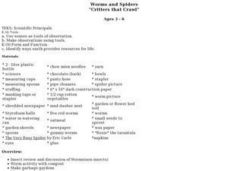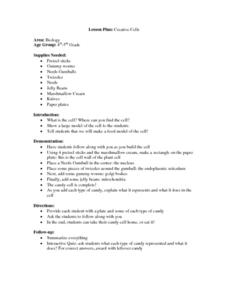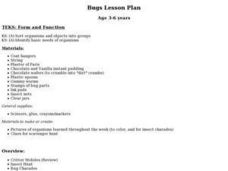Cornell University
Mechanical Properties of Gummy Worms
Learners won't have to squirm when asked the facts after completing an intriguing lab investigation! Hook young scholars on science by challenging them to verify Hooke's Law using a gummy worm. Measuring the length of the worm as they...
Curated OER
Worms and Spiders: "Critters That Crawl"
Students complete a unit of lessons on spiders and worms. They discuss worm and spider characteristics, create a garbage garden, observe worms, create gummy worm prints, read the book, 'The Very Busy Spider,' and construct a spider and...
Curated OER
Centimeter Slinkies
Third graders estimate and measure the length of a whole color-segmented, candy gummy worm. Then, as students bite off each segment, they estimate, measure and record findings in an activity log.
Curated OER
The Gummy Worm Lab
Students participate in a lab experiment with gummy worms. In groups, they record the qualitative and quantitative observations during the lab. They use their senses to make inferences about the experiment and share them with the class.
Baylor College
Animals' Needs
Explore the wonderful world of earthworms as your class learns about the requirements of animal life. After building soda bottle terrariums, students observe worms over the course of a couple weeks, building an understanding that all...
Curated OER
Dirt Cups
After a hard day examining and dissecting worms, why not put your feet up and snack on a few? Here is a really cute idea that can be used to celebrate Earth Day or to accent a thematic learning experience. Kids use clay pots, gummy...
Curated OER
Wonderful Worms
Students identify living and non-living things and explain the importance of earthworms to the soil. They name some basic facts about earthworms, recognize basic worm vocabulary words and demonstrate vermicomposting techniques.
Curated OER
Biology: Creative Cells
Students use various snacks to make large models of human cells. Items such as gumballs, gummy worms, and jelly beans represent the nucleus, golgi bodies, and mitochondria. As each piece of candy is added, the teacher explains what it...
Curated OER
Living-Nonliving
Students determine that environments have living and nonliving parts. They discuss what makes something a living thing and something a nonliving thing. They make a chart and list characteristics of living things and nonliving things.
Grand Erie District School Board
Model Cell Project
If you're finishing up a unit on cells, here's a great project to get kids collaborating and recalling what they've learned in a fun and tangible way. Small groups create plant or animal cells out of materials they have at home. They use...
Curated OER
Polymers all Over the Place
Students investigate properties of common molecules. In this chemistry lesson, students construct polymer models to gain a better understanding of the properties of polymers.
Curated OER
Beautiful Birds
Students engage in a lesson that is about birds while taking part in a variety of activities that are like the following. They play a game that is used for increasing memory while using bird pictures. Students also create a collage with...
Curated OER
Beautiful Birds
Students explore the traits of birds to uncover information about their eggs, feathers, beaks and other characteristics. The data is probed through a variety of exploration centers.
Curated OER
Bird Bodies
Students read about and explore the different types of birds. They discuss how all birds are alike and what makes some different from the others. They experiment picking up "food items" using different tools that represent different...
Curated OER
A House for Me- Ocean Environments
Students explore ocean environments. In this ocean environment lesson, students identify the things ocean animals need for survival. Students use KWL charts and search the Internet collecting information about ocean habitats....
Alabama Learning Exchange
Light Reflection and Absorption
Students discover what types of objects reflect and absorb light. In this science inquiry activity, students use flashlights to determine whether different objects absorb or reflect light.
Curated OER
Interactions Among Living Things
Students role play predators and prey, classify organisms as predator or prey, and describe factors that affect population growth and size.
Curated OER
Bugs Lesson Plan
Students complete a unit of lessons on insects. They participate in a bug hunt, construct paper flowers, discuss pollination, create bug paperweights and insect mobiles, play bug charades, and participate in a bug scavenger hunt.
Curated OER
Edible Soil
Students examine the components of the soil in their community. Following directions, they create their own edible soil to be eaten at the end of the activity. They discuss what makes soils around the world different from those found...
Curated OER
What Makes A Bird A Bird?
Students identify the characteristics of birds and explain how these characteristics are useful in their survival. They explain how both physical and environmental adaptations help birds survive and reproduce. Students create an...
Curated OER
Local Organism Sort
Students determine what characteristics are useful in classifying items. In this sorting organisms lesson students create and explain a classification scheme using familiar organisms.
Curated OER
Edible Soil
Learners model the soils layers using Oreo's. In this lesson students use their favorite food items to create a model of soil layers. A discovery lesson from a youth camp is adapted for classroom modeling and discussion of soil...
Curated OER
Animal Adaptations: Focus on Bird Beaks
Sixth graders explore bird beaks as animal adaptation. In this bird adaptation lesson, 6th graders conduct an experiment to determine the connection between the shape of a bird's beak and the food it eats.
Curated OER
Coral Reef Restaurant
Students explore coral reefs by re-enacting different reef organisms.
Other popular searches
- Measuring Gummy Worms
- Gummy Worms and Measurement
- Gummy Worms and Writing
- Graphing Gummy Worms
- Observing Gummy Worms
- Gummy Worms Fractions
- Gummy Worms and Ecosystems
- Inch Worm, Gummy Worms
- Inch Worm Gummy Worms
- Gummy Worms Chromosomes























